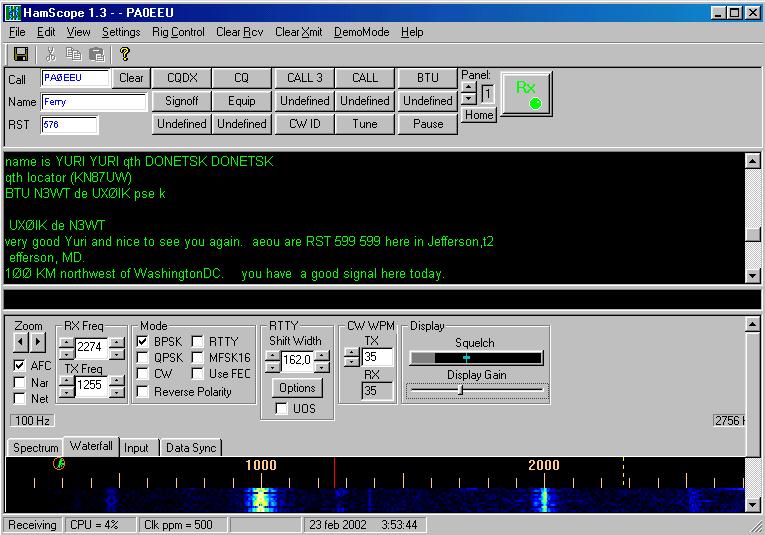




![]()
Phase Shift Keying
The 31 baud BPSK (Bi-Phase Shift Keying) modulation system used in PSK31 was introduced by SP9VRC in his SLOWBPSK program written for the EVM. Instead of the traditional frequency-shift keying, the information is transmitted by patterns of polarity-reversals (sometimes called 180-degree phase shifts). This process can be thought of as equivalent to sending information by swapping-over the two wires to the antenna, although, of course, the keying is more usually done back in the audio input into the transceiver. A well-designed PSK system will give better results than the conventional FSK systems that amateurs have been using for years, and is potentially capable of operation in much narrower bandwidths than FSK. The 31 baud data rate was chosen so that the system will just handle hand-sent typed text easily.
There is a problem with PSK keying which doesn't show up with FSK, and that is the effect of key-clicks. We can get away with hard FSK keying at moderate baud rates without generating too much splatter, but polarity reversals are equivalent to simultaneous switching-off of one transmitter and switching-on of another one in antiphase: the result being key clicks that are TWICE AS BAD as on-off keying, all other things being equal. So if we use computer logic to key a BPSK modulator such as an exclusive-or gate, at 31 baud, the emission would be extremely broad. In fact it would be about 3 times the baud rate wide at 10dB down, 5 times at 14dB down, 7 times at 17dB down, and so on (the square wave Fourier series in fact)
The PSK31 philosophy is to stay at the speed needed to handle hand-keyed text, so why do we consider QPSK at all? The answer is that we can use the extra capacity to reduce the error-rate while keeping the bandwidth and the traffic speed the same. Note that because we have a 3dB SNR penalty with QPSK, any error-correction scheme we introduce has to be at least good enough to correct the extra errors which result from the 3dB SNR penalty, and preferably a lot more, or it will not be worth doing. By doing simulations in a computer, and tests on the bench with a noise generator, it has been found that when the bit error-rate is less than 1% with BPSK, it is much better than 1% with QPSK and error-reduction, but when the BER is worse than 1% on BPSK, the QPSK mode is actually worse than BPSK. Therefore, if we are dealing with radio paths where the signal is just simply very noisy, there is actually no advantage to QPSK at all!
In December 1997, PSK31 introduced the QPSK (Quadrature Phase Shift Keying). In this mode, instead of just keying by phase reversals, that is, 180-degree phase-shift, an additional pair of 90 and 270 degree phase-shifts are possible. If you thought of BPSK as reversing the polarity of the signal, then QPSK can be thought of as two BPSK transmitters on the same frequency but 90 degrees out of phase with each other. By thinking of the receiver as being two BPSK demodulators at 90 degrees, we have two channels sharing the same frequency, but of course, with only half the transmitter power in each. We therefore have twice the bit-rate but at 3dB less signal-to-noise ratio. We could use this feature to transmit data at twice the speed with 3dB less noise margin.
A very good reader on the basics of PSK can be found on URL: http://www.cpinternet.com/~lyle/watsbpsk.htm

This is an example of the screen display of Hamscope Version 1.3 The BPSK (PSK31) box is checked. If the QPSK box is checked the program will code and decode this mode. As you can see from the other boxes Hamscope has a lot of possibilities!